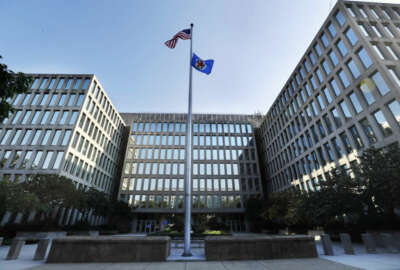NWS enlists help to spread message, improve storm preparation
The National Weather Service launched the ambassador program in February, and it now has more than 350 private sector, state, local, federal agency and other...
The National Weather Service is recruiting federal agencies to be ambassadors as part of its Weather-Ready Nation initiative, just as hurricane season kicks into high gear.
NWS says ambassadors are helping citizens and businesses prepare for weather emergencies by ensuring a consistent and broad message goes out about how to best prepare for tornadoes, hurricanes and other weather-related emergencies.
“NWS can’t do it alone. We have so many partners and so many people that need to help us build a Weather-Ready Nation. So that’s where our ambassador initiative really came along,” said Laura Furgione, the deputy director for the National Weather Service, in an exclusive interview with Federal News Radio. “It’s making sure that external organizations are helping us make the country ready, responsive and resilient to weather, water and climate events. It’s even events that aren’t necessarily weather related, but everything is weather dependent, so folks have to be prepared.”
NWS launched the ambassador initiative in February, and already 350 businesses, organizations, and state, local and federal agencies have signed up.

“Weather-Ready Nation ambassadors need to set the example for themselves and for their office and their home so they are prepared in the event of extreme weather,” Furgione said.
FEMA is the latest federal agency to sign on to be an ambassador. She said FEMA joined the departments of Labor, Justice and Housing and Urban Development, as well as components within the Defense, Energy and Homeland Security departments, and the National Institute of Standards and Technology.
But Furgione said several other key federal agencies are missing from the list.
She said the Coast Guard, NASA and the U.S. Geological Survey aren’t participating yet in the ambassador program.
“What we’ve seen is those departments and agencies that have a well-established partnership with us are taking a little longer to get on board because of that complexity of their relationship,” Furgione said. “They want to make sure they can live up to the commitment of setting that example and promoting our key messages for the Weather Nation.”
NWS said ambassadors must commit to:
- Promoting Weather-Ready Nation messages and themes to their stakeholders;
- Engaging with NOAA personnel on potential collaboration opportunities;
- Sharing their success stories of preparedness and resiliency;
- Serving as an example by educating employees on workplace preparedness.
Additionally, NWS says ambassadors would receive toolkits for preparedness weeks and planning information. The goal is to create a greater dialogue among stakeholders that will end in innovative opportunities for collaboration to prepare for bad weather.
“It’s really about making sure the information we put out is reiterated consistently,” Furgione said. “The ambassadors have to actually pledge to promote our key messages in their outreach activities.”
Furgione said a perfect example of this inconsistency came in February 2010 during the snow storm now known as “Snowmageddon.”
“Some of our forecasts, even though it said we were going to have snow that day, we didn’t give enough specific information that the snow was going to happen and it was going to fall two inches an hour during rush hour,” she said. “That’s a significant difference than two inches of snow falling throughout the day lightly where the road crews could keep up with that.”
New technology apps
Along with federal agencies, several government contractors also have signed on, including Raytheon, Northrop Grumman, Harris and Ball Aerospace and Technologies.
In addition to the Weather-Ready Nation and ambassador initiative, Furgione said NWS launched an experimental storm surge inundation mapping product and a five-day graphical tropical outlook, which shows areas where hurricanes or tropical storms may form five days out.
These two new services are part of how NWS is offering better applications and using data differently to help inform and educate the public during hurricane season.
“Our sister agency, the National Ocean Service, we partner with them on the storm surge inundation mapping product, and also others, as well. One of the keys with that product was in the past, folks still had to incorporate the high tide or low tide. Now that product will have that information included,” Furgione said. “That’s going to have information on the worst case scenario on what a storm may potentially bring to a community, and they can actually see graphically where the water could potentially rise.”
She said these efforts are to make sure the NWS forecasts are actionable and consistent so citizens, businesses and governments can understand how best to prepare ahead of time.
“I hope everyone is prepared. We can see severe weather any month of the year,” Furgione said. “With hurricane season, even though we are expecting a normal or below normal season, it only takes one storm. So be prepared.”
RELATED STORIES:
NWS: Many in Joplin ignored 1st tornado warnings
Weather Services site overload prevented access
USPTO battles Snowmageddon with telework
Copyright © 2024 Federal News Network. All rights reserved. This website is not intended for users located within the European Economic Area.
Jason Miller is executive editor of Federal News Network and directs news coverage on the people, policy and programs of the federal government.
Follow @jmillerWFED






